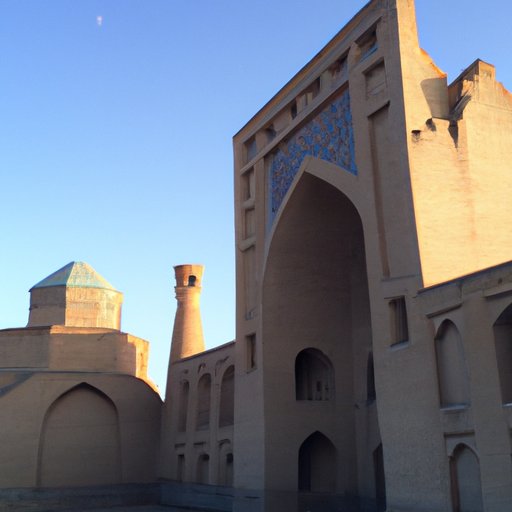Introduction
Architecture is the art, science, and practice of designing and constructing buildings, monuments, and other physical structures. Throughout history, architects have used their creativity and technical skills to create iconic buildings that have become symbols of cities and countries, while also providing functional spaces for people to live, work, and play. This article will explore the global history of architecture, analyzing the influence of different architectural styles across time and place, examining the history of major structures around the world, discussing the relationship between religion and architecture, investigating the social and cultural significance of global buildings, and examining the role of technology in advancing architectural design.

Analyzing the Influence of Different Architectural Styles Across Time and Place
Architectural styles have evolved over time, reflecting changing cultural values and technological advancements. Ancient styles of architecture were often characterized by large, grandiose structures with ornate decorations and intricate details. Examples of ancient and classical buildings include the Parthenon in Athens, the Colosseum in Rome, and the Great Pyramid of Giza in Egypt.
Gothic and Renaissance structures emerged during the Middle Ages and early modern period and featured an emphasis on symmetry, balance, and proportion. Notable examples include the Notre Dame Cathedral in Paris and St. Peter’s Basilica in Rome. Baroque and Rococo architecture developed in the 17th and 18th centuries and featured more elaborate designs with curved lines and ornamental decorations. Examples of Baroque and Rococo architecture include the Palace of Versailles in France and St. Paul’s Cathedral in London.
The Industrial Revolution saw the development of Neoclassical architecture, which was characterized by the use of columns and arches. Examples of Neoclassical architecture include the U.S. Capitol Building in Washington D.C. and the Brandenburg Gate in Berlin. In the late 19th and early 20th centuries, modernist and postmodernist styles began to emerge, characterized by the use of steel, glass, and concrete and an emphasis on functionality and minimalism. Famous examples of modernist architecture include the Empire State Building in New York City and the Sydney Opera House in Australia.

Exploring the History of Major Structures Around the World
Europe has been home to some of the world’s most iconic structures. The Eiffel Tower in Paris, the Hagia Sophia in Istanbul, and St. Basil’s Cathedral in Moscow are all examples of renowned European landmarks. Asia is home to many ancient structures such as the Taj Mahal in India, the Forbidden City in Beijing, and Angkor Wat in Cambodia. Africa is home to some of the oldest and most impressive structures in the world, including the Great Zimbabwe ruins in Zimbabwe, the rock-hewn churches of Lalibela in Ethiopia, and the pyramids of Giza in Egypt.
In the Americas, there are a number of iconic structures, from the Mayan ruins of Chichen Itza in Mexico to the Christ the Redeemer statue in Brazil. Other notable structures in the Americas include the Statue of Liberty in New York City, the Golden Gate Bridge in San Francisco, and the CN Tower in Toronto.

Examining the Relationship Between Religion and Architecture
Religion has long played a role in the development of architectural styles. Christianity has produced some of the world’s most iconic religious structures, from the medieval cathedrals of Europe to the Gothic Revival churches of the United States. Islamic architecture is characterized by the use of pointed arches, domes, and geometric patterns, and is exemplified by the Taj Mahal in India and the Alhambra palace in Spain. Hindu temples often feature intricately carved statues and ornamental decorations, while Buddhist temples typically feature stupas and pagodas.
Investigating the Social and Cultural Significance of Global Buildings
Architecture plays an important role in society and culture. Buildings serve as symbols of power and prestige, reflecting the values and beliefs of those who inhabit them. For example, the White House in Washington D.C. is a symbol of American democracy, while the Forbidden City in Beijing is a symbol of Chinese imperial power. Buildings can also be used to commemorate important historical events, such as the 9/11 Memorial in New York City or the Hiroshima Peace Memorial in Japan.
Buildings can also be used to express cultural identity. Traditional styles of architecture often reflect the values and beliefs of a particular community or country. The Maori wharenui in New Zealand, for example, are traditional meeting houses used to celebrate the culture of the Maori people. Similarly, the Puebloan cliff dwellings of the American Southwest are a testament to the ingenuity and resourcefulness of the indigenous peoples of the region.
Discussing the Role of Technology in Advancing Architectural Design
Technology has played a significant role in the advancement of architectural design. Pre-modern construction techniques such as masonry, carpentry, and metalworking enabled builders to construct larger, more complex structures. In the modern era, innovations such as steel-frame construction and reinforced concrete have allowed for taller and more structurally sound buildings. Computer-aided design (CAD) has further advanced architectural design, allowing architects to create detailed 3D models of their designs before they are built.
Conclusion
This article has explored the global history of architecture, analyzing the influence of different architectural styles across time and place, examining the history of major structures around the world, discussing the relationship between religion and architecture, investigating the social and cultural significance of global buildings, and examining the role of technology in advancing architectural design. From ancient and classical buildings to modernist and postmodernist structures, architecture has served as an expression of cultural values and beliefs, providing functional spaces for people to live, work, and play.
The findings of this article demonstrate the importance of understanding the history of architecture in order to appreciate its significance in our lives today. Further research is needed to examine the impact of architecture on society and culture, and to understand how advances in technology can be used to improve the design of buildings in the future.
(Note: Is this article not meeting your expectations? Do you have knowledge or insights to share? Unlock new opportunities and expand your reach by joining our authors team. Click Registration to join us and share your expertise with our readers.)
